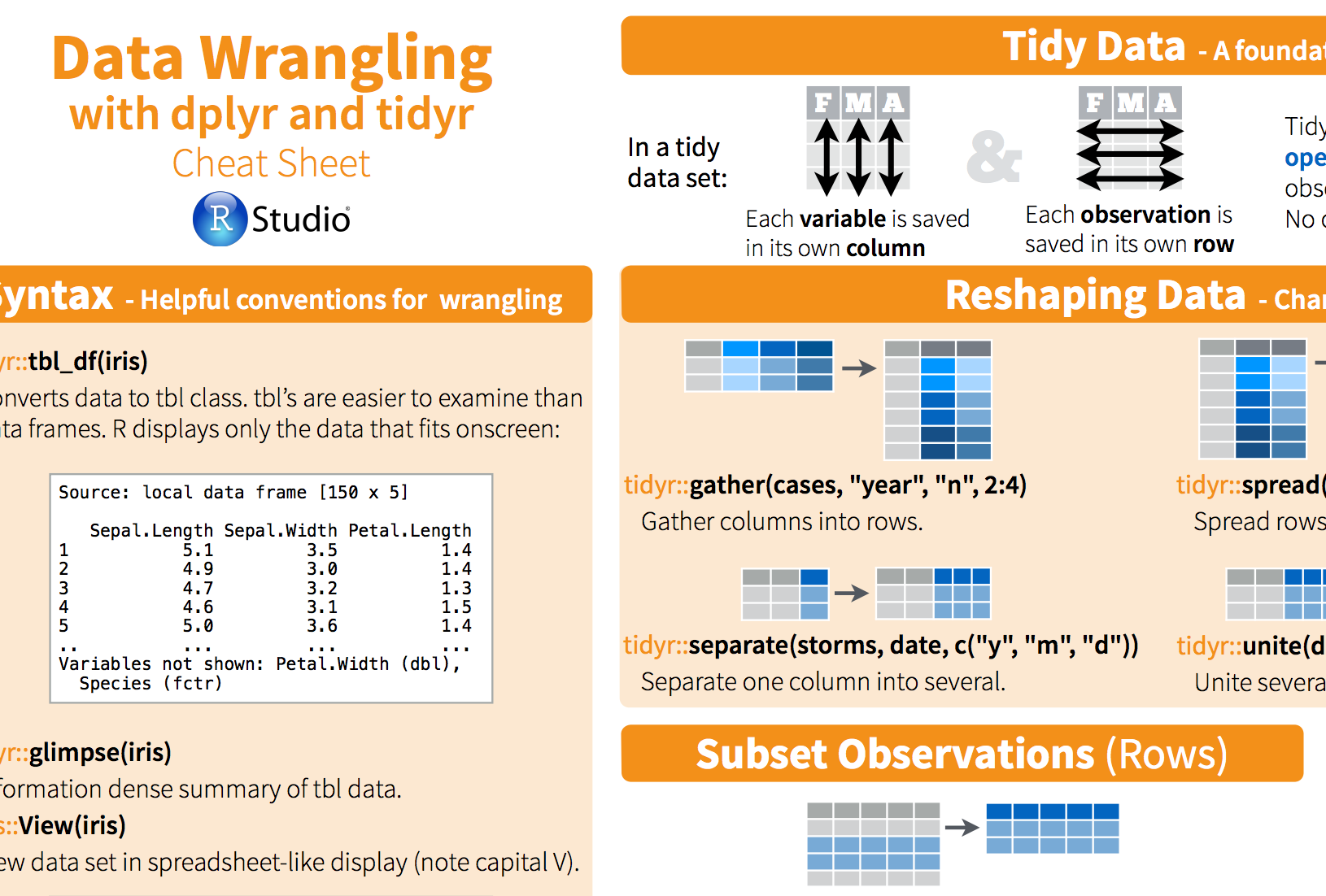- R Dplyr Cheat Sheet
- R Data Manipulation Cheat Sheet
- Tidyverse Cheat Sheet Pdf
- Tibble Cheat Sheet
- R Cheat Sheets Dplyr
- R Studio Dplyr Cheat Sheet
data.table and dplyr cheat-sheet
This tidyverse cheat sheet will guide you through the basics of the tidyverse, and 2 of its core packages: dplyr and ggplot2! The tidyverse is a powerful collection of R packages that you can use for data science. They are designed to help you to transform and visualize data. All packages within this collection share an underlying philosophy and common APIs.
- If you are using R to do data analysis inside a company, most of the data you need probably already lives in a database (it’s just a matter of figuring out which one!). However, you will learn how to load data in to a local database in order to demonstrate dplyr’s database tools. At the end, I’ll also give you a few pointers if you do.
- Dplyr functions work with pipes and expect tidy data. In tidy data: pipes x%% f(y) becomes f(x, y). Data Transformation with dplyr:: CHEAT SHEET A B C A B C.
This is a cheat-sheet on data manipulation using data.table and dplyr package (sqldf will be included soon…) . The package dplyr is an excellent and intuitive tool for data manipulation in R. Due to its intuitive data process steps and a somewhat similar concepts with SQL, dplyr gets increasingly popular. Another reason is that it can be integrated in SparkR seamlessly. Mastering dplyr will be a must if you want to get started with SparkR.

I found this cheat-sheet very useful in using dplyr. My post is inspired by it. I hereby write this cheat sheet for data manipulation with data.table / data.frame and dplyr computation side by side. It is especially useful for those who wants to convert data manipulation style from data.table to dplyr. There are 6 data investigation and manipulation included:
- Summary of data
- subset rows
- subset columns
- summarize data
- group data
- create new data
Select rows that meet logical criteria:
dplyr
data.frame / data.table
Remove duplicate rows:
dplyr
data.table
Randomly select fraction of rows
dplyr
Randomly select n rows
dplyr
data.table / data.frame
Select rows by position
dplyr
data.table / data.frame
Select and order top n entries (by group if group data)
dplyr
data.table
dplyr
data.frame
> iris[c(‘Sepal.Width’,’Petal.Length’,’Species’)]
data.table
Select columns whose name contains a character string
Select columns whose name ends with a character string
Select every column
dplyr
data.frame
Select columns whose name matches a regular expression
Select columns names x1,x2,x3,x4,x5
select(iris, num_range(‘x’, 1:5))
Select columns whose names are in a group of names
Select column whose name starts with a character string
Select all columns between Sepal.Length and Petal.Width (inclusive)
Select all columns except Species.
dplyr
data.frame
The package dplyr allows you to easily compute first, last, nth, n, n_distinct, min, max, mean, median, var, st of a vector as a summary of the table.
R Dplyr Cheat Sheet
Summarize data into single row of values
dplyr
Apply summary function to each column
Note: mean cannot be applied on Factor type.
Count number of rows with each unique value of variable (with or without weights)
dplyr
data.table:

aggregate {stats}
Group data into rows with the same value of Species
dplyr
data.table: this is usually performed with some aggregation computation
Remove grouping information from data frame
dplyr

Compute separate summary row for each group
dplyr
data.frame
data.table
R Data Manipulation Cheat Sheet
Mutate used window function, function that take a vector of values and return another vector of values, such as:
compute and append one or more new columns
data.frame / data.table
dplyr
Apply window function to each column
Tidyverse Cheat Sheet Pdf
dplyr
base
data.table

Compute one or more new columns. Drop original columns
Compute new variable by group.
dplyr
iris %>% group_by(Species) %>% mutate(ave = mean(Sepal.Length))
data.table
Tibble Cheat Sheet
iris[, ave:=mean(Sepal.Length), by = Species]
R Cheat Sheets Dplyr
data.frame
R Studio Dplyr Cheat Sheet
You can verify the result df1, df2 using:
